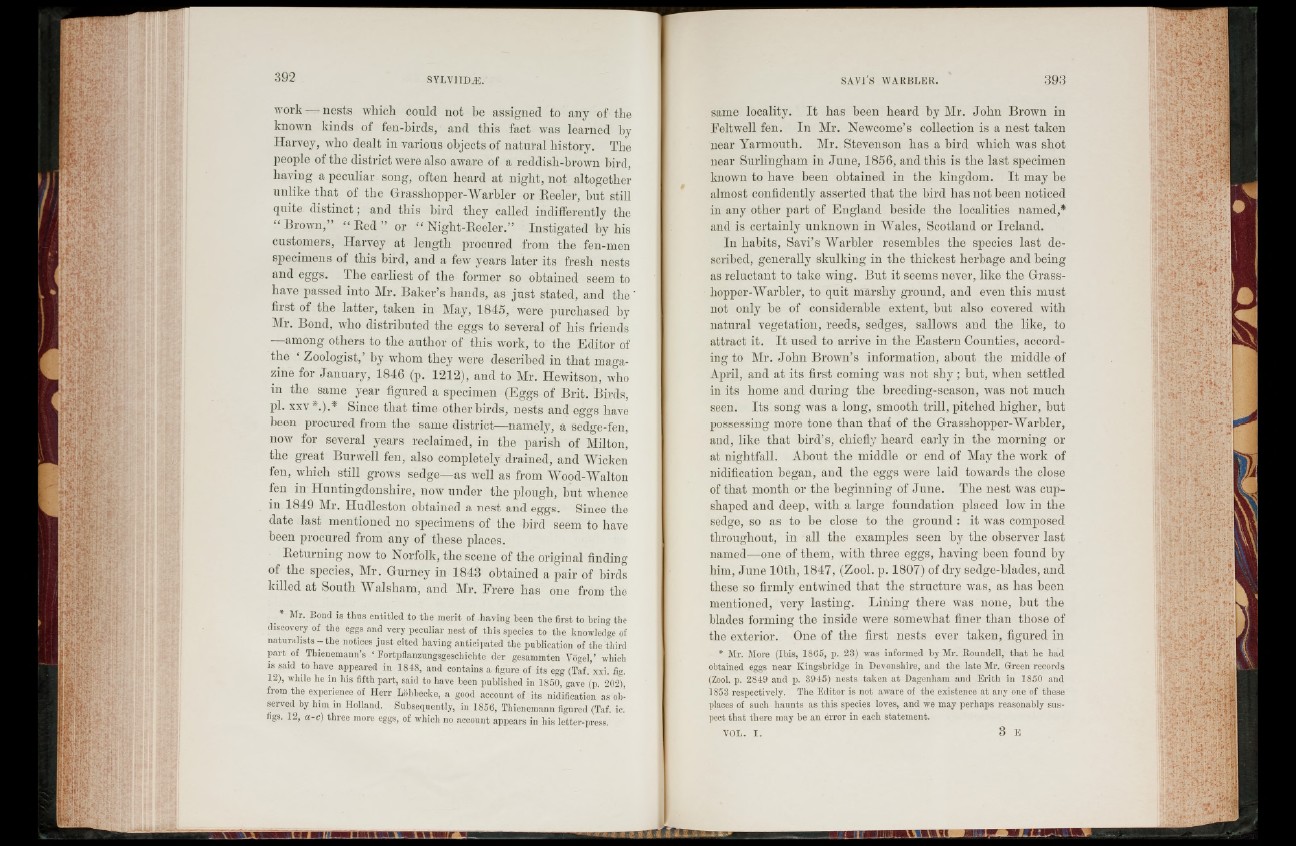
work — nests which could not be assigned to any of the
known kinds of fen-birds, and this fact was learned by
Harvey, who dealt in various objects of natural history. The
people of the district were also aware of a reddish-brown bird,
having a peculiar song, often heard at night, not altogether
unlike that of the Grasshopper-Warbler or Reeler, hut still
quite distinct; and this bird they called indifferently the
“ Brown,” “ Re d ” or “ Night-Reeler.” Instigated by his
customers, Harvey at length procured from the fen-men
specimens of this bird, and a few years later its fresh nests
and eggs. The earliest of the former so obtained seem to
have passed into Mr. Baker’s hands, as just stated, and th e '
fiist of the latter, taken in May, 1845, were purchased by
Mr. Bond, who distributed the eggs to several of his friends
—among others to the author of this work, to the Editor of
the ‘ Zoologist,’ by whom they were described in that magazine
for January, 1846 (p. 1212), and to Mr. Hewitson, who
in the same year figured a specimen (Eggs of Brit. Birds,
pi. xxv *.).* Since that time other birds, nests and eggs have
been procured from the same district—namely, a sedge-fen,
now for several years reclaimed, in the parish of Milton,
the great Bur well fen, also completely drained, and Wicken
fen, which still grows sedge—as well as from Wood-Walton
ten in Huntingdonshire, now under the plough, hut whence
in 1849 Mr. Hudleston obtained a nest and eggs. Since the
date last mentioned no specimens of the bird seem to have
been procured from any of these places.
Returning now to Norfolk, the scene of the original finding
of the species, Mr. Gurney in 1843 obtained a pair of birds
lulled at South Walsham, and Mr. Frere has one from the
Mr. Bond is thus entitled to the merit of haring been the first to hring the
discovery of the eggs and very peculiar nest of this species to the knowledge of
n a tu ra lis ts-th e notices just cited having anticipated the publication of the third
part of Thienemann’s ‘ Fortpflanzungsgesehichte der gesammten Vogel,’ which
is said to have appeared in 1848, and contains a figure of its egg (Taf. xxi. fig.
12), while he in his fifth part, said to have been published in 1850, gave (p 202)
from the experience of Herr Lobbecke, a good account of its nidification as observed
by him in Holland. Subsequently, in 1856, Thienemann figured (Taf. ic.
figs. 12, a-c) three more eggs, of which no account appears in his letter-press.
same locality. I t has been heard by Mr. John Brown in
Feltwell fen. In Mr. Newcome’s collection is a nest taken
near Yarmouth. Mr. Stevenson has a bird which was shot
near Surlingham in June, 1856, and this is the last specimen
known to have been obtained in the kingdom. I t may he
almost confidently asserted that the bird has not been noticed
in any other part of England beside the localities named,*
and is certainly unknown in Wales, Scotland or Ireland.
In habits, Savi’s Warbler resembles the species last described,
generally skulking in the thickest herbage and being
as reluctant to take wing. But it seems never, like the Grasshopper
Warbler, to quit marshy ground, and even this must
not only he of considerable extent, hut also covered with
natural vegetation, reeds, sedges, sallows and the like, to
attract it. I t used to arrive in the Eastern Counties, according
to Mr. John Brown’s information, about the middle of
April, and at its first coming was not sh y ; hut, when settled
in its home and during the breediug-season, was not much
seen. Its song was a long, smooth trill, pitched higher, hut
possessing more tone than that of the Grasshopper-Warbler,
and, like that bird’s, chiefly heard early in the morning or
at nightfall. About the middle 01* end of May the work of
nidification began, and the eggs were laid towards the close
of that month or the beginning of June. The nest was cupshaped
and deep, with a large foundation placed low in the
sedge, so as to he close to the ground : it was composed
throughout, in all the examples seen by the observer last
named—one of them, with three eggs, having been found by
him, June 10th, 1847, (Zool. p. 1807) of dry sedge-blades, and
these so firmly entwined that the structure was, as has been
mentioned, very lasting. Lining there wras none, but the
blades forming the inside were somewhat finer than those of
the exterior. One of the first nests ever taken, figured in
* Mr. More (Ibis, 1865, p. 23) was informed by Mr. Roundell, that he had
obtained eggs near Kingsbridge in Devonshire, and the late Mr. Grreen records
(Zool. p. 2849 and ji. 3945) nests taken at Dagenham and Erith in 1850 and
1853 respectively. The Editor is not aware of the existence at any one of these
places of such haunts as this species loves, and we may perhaps reasonably suspect
that there may be an error in each statement.
VOL. I . 3 E